When choosing gemstone certification, prioritize reputable labs like GIA, AGS, or IGI depending on your needs. GIA offers the gold standard, while AGS excels in cut grading and IGI provides faster turnaround. Look for security features, treatment disclosures, and matching specifications. Beware of vague descriptions or inconsistent measurements. Compare grading standards carefully as they affect value. Higher certification costs typically translate to better resale value and confidence in your investment.
10 Tips: Major Gemstone Lab Certification Guide
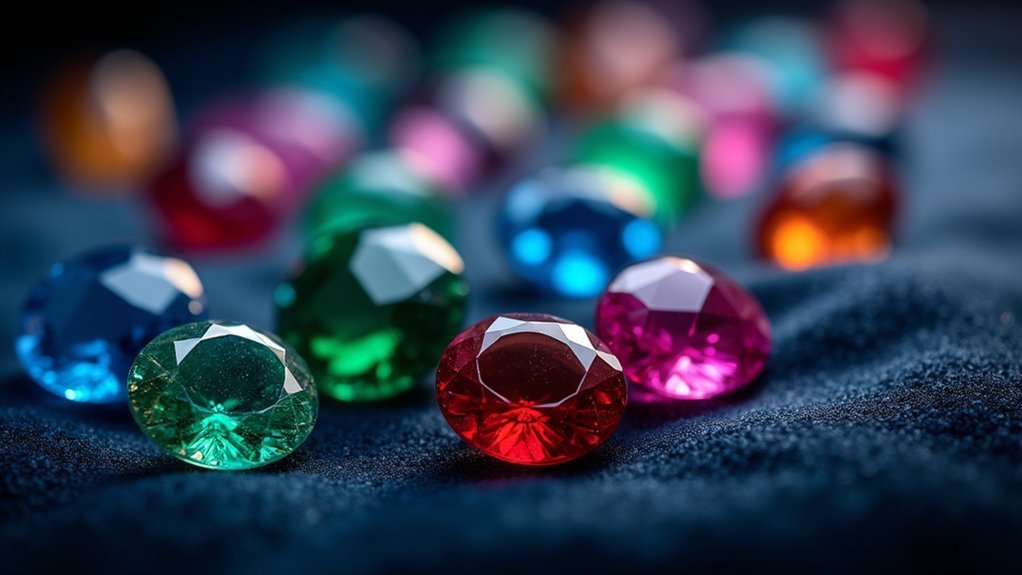
Five major certification labs dominate the gemstone authentication landscape, each with distinctive strengths. When seeking Gemstone Certificates, consider your priorities: the Gemological Institute of America (GIA) offers the gold standard in the grading system, particularly valued by serious collectors prioritizing credibility.
For cut-quality emphasis, AGS provides specialized assessment using their 0-10 scale. If you’re budget-conscious or need quick turnaround, IGI balances efficiency with reliability.
European buyers often prefer HRD Antwerp’s certificates, which maintain rigorous standards similar to GIA.
GCAL’s unique Gemprint technology offers additional security for high-value colored gemstones. Understanding each lab’s certification process helps both buyers and sellers make informed decisions about quality and authenticity documentation that best suits their specific gemstone needs.
Understanding the Purpose of Gemstone Certification
Beyond selecting the appropriate lab for certification, you’ll need to grasp why gemstone certification matters in the first place.
Gemstone certification serves as your guarantee of authenticity and quality, confirming you’re purchasing a genuine natural stone rather than a synthetic alternative.
When you invest in high-value gemstones, certificates provide detailed assessments of color, clarity, cut, and carat weight—factors directly impacting market value.
This documentation from a reputable gemological laboratory offers objective evaluations that enable you to compare similar stones with confidence.
The transparency in transactions that certification creates protects you from potential fraud by clearly documenting any treatments or enhancements applied to the stone.
This information guarantees you understand exactly what you’re buying and its true worth in the marketplace.
Comparing the “Big Three” Certification Labs: GIA, AGS, and IGI
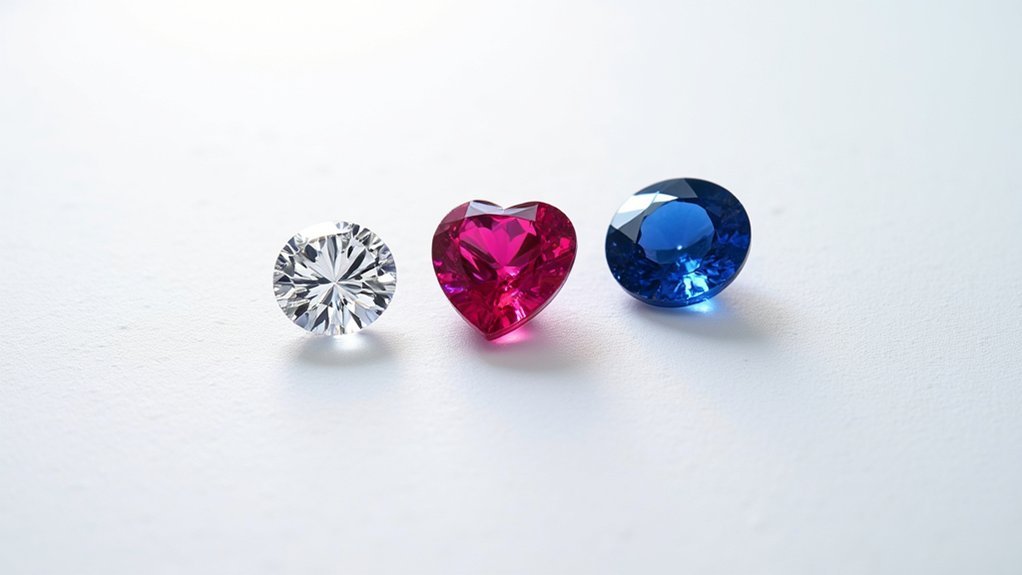
When maneuvering through the world of gemstone certification, you’ll encounter three dominant laboratories that set industry standards: GIA, AGS, and IGI.
GIA offers the most recognized 4Cs grading system, providing thorough reports that greatly impact a stone’s value.
The GIA’s renowned 4Cs grading system delivers comprehensive reports that significantly influence a gemstone’s market worth.
In contrast, AGS uses a unique 0-10 scale, emphasizing cut quality and ethical practices—making it a leader in consumer protection.
IGI stands out for its accessibility, faster turnaround times, and competitive pricing, making it popular in high-volume markets where quick certification is essential.
When comparing these labs, remember that each uses distinct methodologies.
While GIA and AGS maintain stricter standards often preferred for high-value purchases, IGI provides a practical alternative for more affordable gemstone certification without sacrificing reliability.
Key Elements to Look for on Any Gemstone Certificate
When examining a gemstone certificate, you’ll want to verify its security features like holograms, watermarks, or QR codes that protect against forgeries and confirm authenticity.
Treatment disclosure details reveal any enhancements applied to the stone, such as heat treatment, irradiation, or clarity enhancement, which greatly impact its value and longevity.
These critical elements complement basic identification information and provide transparency about modifications that mightn’t be visible to the naked eye.
Security Feature Verification
Although counterfeiting exists in the gemstone industry, you can protect yourself by knowing how to verify certificate security features.
Always check for a unique certificate number that allows tracking and authentication of your document through the issuing laboratory’s database.
Examine the certificate for sophisticated security elements like holograms and watermarks that prevent forgery. Legitimate certificates from reputable labs feature distinctive logos that indicate credibility. These visual markers shouldn’t appear distorted or unclear.
Ensure the document contains detailed gemstone characteristics that match what you see when examining the stone. The certificate should specify carat weight, dimensions, color grade, and clarity assessment.
Finally, verify the certificate includes complete contact information for the issuing laboratory, allowing you to confirm its authenticity directly with the source if needed.
Treatment Disclosure Details
Perhaps the most essential section on any gemstone certificate is the treatment disclosure, which reveals modifications made to enhance the stone’s appearance.
When examining certification, you’ll want to verify the specific treatments applied—whether heating, dyeing, or clarity enhancement—as these greatly impact market value.
Reputable labs like GIA and AGS prioritize transparency in the gemstone certification process by detailing whether enhancements are permanent or temporary, affecting both the stone’s longevity and investment potential.
Be wary of certificates lacking clear treatment information, as this omission raises serious concerns about authenticity.
Remember that a stone’s treatment history directly correlates with its worth—untreated stones typically command premium prices.
Knowledge of these enhancements empowers you to make informed decisions and guarantees you’re paying an appropriate amount for your gemstone’s true qualities.
Decoding Color and Clarity Grades Across Different Labs
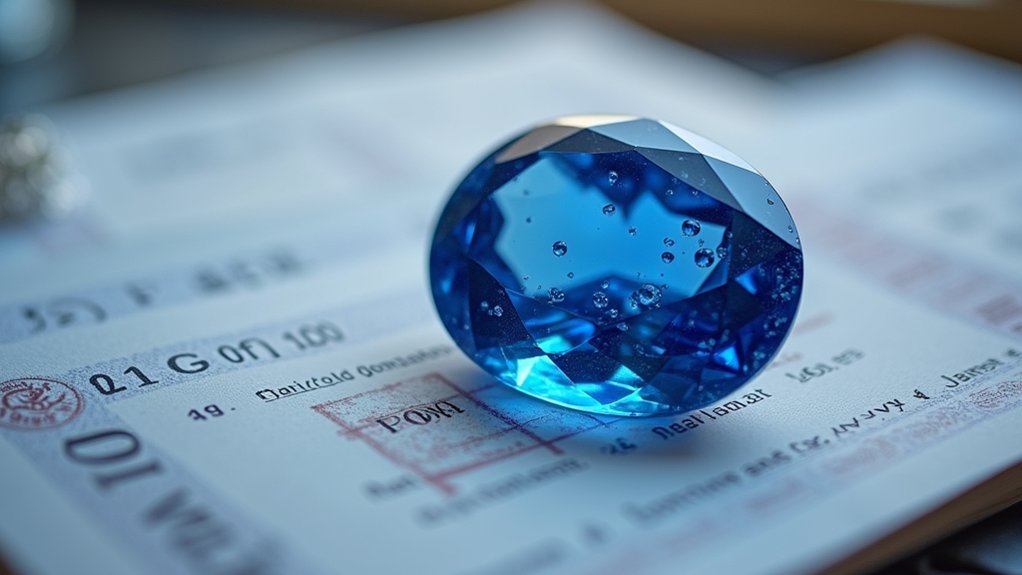
Recognizing how GIA’s alphabetical color scale (D-Z) differs from AGS’s numerical system (0-10) will help you accurately interpret gemstone certificates from various labs.
When comparing clarity grades, you’ll notice significant variations—GIA’s 11-category system from FL to I3 might evaluate the same stone differently than IGI’s potentially more lenient standards.
These grading disparities directly impact a gemstone’s market value and price point, making it essential to understand each lab’s specific terminology when making purchasing decisions.
Lab Color Terminology Differences
When comparing gemstone certificates from different labs, you’ll encounter a maze of varying color and clarity terminology that can greatly impact your purchasing decisions. The subjective assessments used in gemological certification create significant differences in how color grading is communicated across laboratories.
| Lab | Color Terminology Approach |
|---|---|
| GIA | Alphabetical scale (D-Z); focuses on hue, tone, saturation |
| AGS | Numerical scale (0-10); emphasizes cut quality with color |
| IGI | Unique interpretations; may differ from GIA standards |
| HRD | European perspective; slight variations in grading thresholds |
| GSL | May use different descriptive language for same characteristics |
Understanding these differences is vital, as clarity grades and treatment disclosure practices also vary between labs. A stone graded “Excellent” by one lab might receive a different designation elsewhere, affecting perceived value and price.
Clarity Scales Compared
Just as color terminology varies between labs, clarity grading systems present their own set of complexities that you’ll need to navigate when comparing gemstone certificates.
GIA’s clarity grade standard runs from Flawless (FL) to Included (I), while AGS uses a similar scale but emphasizes cut quality more heavily in their grading reports.
You’ll notice that labs like IGI and GSI follow comparable scales to GIA but may grade slightly more leniently. This variance can greatly impact a gemstone’s quality assessment and pricing.
For colored gems, clarity assessments focus on “eye-clean” visibility rather than magnification standards.
Always check if treatments affecting clarity (like heat or oiling) are noted on gem certification documents.
Understanding these differences between clarity assessments from various labs guarantees you’re making well-informed purchasing decisions.
Grade Value Implications
The financial implications of gemstone grades vary dramatically across certification laboratories, affecting everything from retail pricing to investment potential.
When comparing gemstone certifications, you’ll notice that GIA’s conservative grading approach often translates to higher market value compared to identical stones graded by less stringent labs.
Understanding these differences is essential – a diamond with VS1 clarity from GIA might receive a higher grade elsewhere, potentially impacting resale value.
Similarly, AGS’s emphasis on cut quality often results in premium pricing for stones with excellent light performance.
For colored gemstones, vivid saturation typically commands higher prices regardless of the grading system used.
Remember that certification choice isn’t just paperwork – it’s a value decision. Respected labs like GIA provide standardized grading that builds buyer confidence and preserves your investment’s worth.
How Lab Certification Affects Gemstone Value and Resale Potential
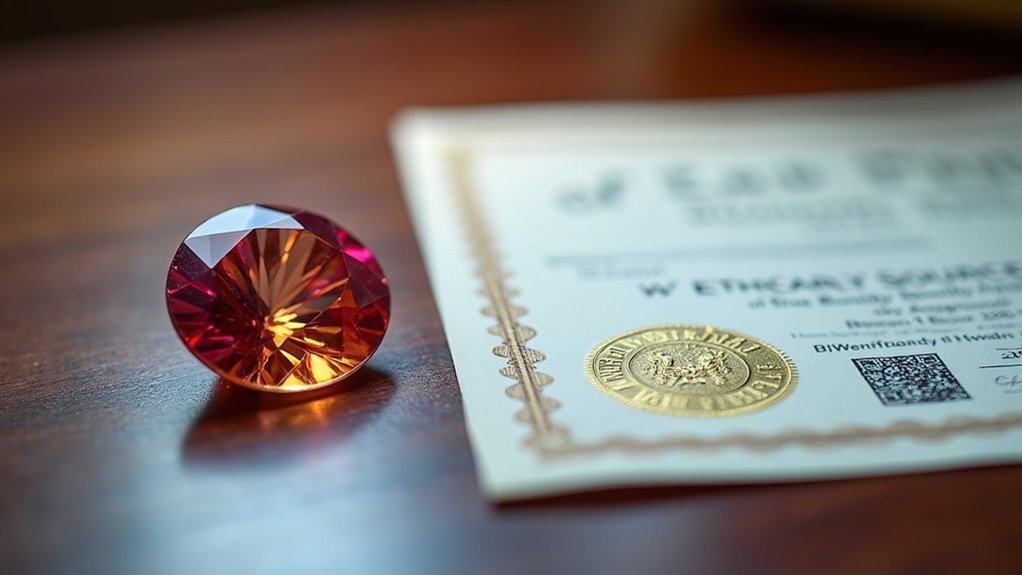
Investing in certified gemstones can dramatically increase both their immediate market value and long-term resale potential. Reputable certification from labs like GIA or AGS serves as a quality guarantee, documenting vital characteristics such as color, clarity, and cut that determine gem quality.
When you purchase certified gemstones, you’re gaining a significant advantage in future resale opportunities. Buyers consistently prefer stones with documentation because it eliminates uncertainty about authenticity. Your insurance valuations will also benefit, as many insurers require certification to establish accurate replacement costs.
For colored gemstones, certification that verifies treatment history and origin is particularly valuable. Untreated stones from prestigious regions command premium prices, making proper documentation essential for maximizing your investment.
Don’t underestimate how certification transforms a beautiful stone into a verified valuable asset.
Special Considerations for Colored Gemstone Certification
While diamond grading follows standardized protocols, colored gemstone certification presents unique challenges with origin identification often requiring advanced spectrometry and reference databases.
You’ll need to understand treatment disclosure standards, as enhancements like heat treatment or diffusion greatly impact value and must be transparently documented by reputable labs.
Certain inclusions in colored stones, unlike diamonds where they typically reduce value, can authenticate natural formation or specific origins, potentially increasing a gemstone’s market worth.
Origin Identification Challenges
Determining a colored gemstone’s geographic origin presents some of the most complex challenges in gemological certification, particularly because stones from different regions often share remarkably similar characteristics.
When you submit gemstones to a reputable Gemological Institute, they’ll employ advanced techniques to establish geographical origin—a critical factor affecting gemstone value and authenticity.
Origin declarations on certification reports greatly impact market pricing, with untreated stones from prestigious locations commanding premium prices. You’ll find this especially true for iconic varieties like Kashmir sapphires and Burmese rubies.
Three key aspects of origin identification challenges include:
- Overlapping trace element signatures between different mining locations
- The need for multiple analytical methods to confirm origin conclusions
- Limitations in identifying origins of heavily treated stones that have altered characteristics
Treatment Disclosure Standards
Because colored gemstones undergo various enhancement methods to improve their appearance, treatment disclosure stands as a cornerstone of ethical gemological certification.
You’ll find that both the Gemological Institute of America (GIA) and American Gem Society (AGS) maintain strict guidelines requiring all enhancements made to a gemstone be explicitly documented.
When purchasing high-value colored gemstones like sapphires, rubies, or emeralds, make certain certification clearly states treatments such as heating, dyeing, or fracture filling.
This transparency directly impacts market value—untreated stones typically command considerably higher prices than treated counterparts.
Value-Impacting Inclusions
Unlike diamonds where flawless clarity reigns supreme, colored gemstones follow different evaluation standards when it comes to inclusions. The value of a gemstone often depends on how these internal features affect its overall quality and appearance.
When reviewing certification reports, you’ll want to understand how inclusions impact your potential purchase.
- Origin indicators – Certain inclusions serve as geographic fingerprints through scientific analysis, potentially increasing a stone’s value if from prestigious sources.
- Treatment disclosure relevance – Inclusions can reveal undisclosed treatments; labs will document these enhancements which greatly affect pricing.
- Visibility threshold – Eye-visible inclusions typically reduce value more drastically than microscopic ones, with exceptions for certain “silk” inclusions in stones like star sapphires.
Understanding these factors helps you make informed decisions when investing in colored gemstones.
Spotting Red Flags in Gemstone Certificates
While traversing the world of gemstone purchases, you’ll need to develop a critical eye for gemstone certificates, as they can make the difference between a wise investment and a costly mistake.
Always prioritize certificates from reputable laboratories like GIA or AGS, whose high standards and rigorous grading practices guarantee accurate assessments of a gemstone’s quality.
Be wary of certificates with vague descriptions lacking specific color or clarity details, or those making grandiose claims about “flawless” stones without proper documentation.
Check for inconsistencies in reported measurements and weight, which can signal misrepresentation. Verify authenticity through unique identification numbers and security features like holograms.
Remember that visible inclusions should be properly documented—certificates that gloss over these details often hide compromised quality or authenticity issues.
When to Request Additional Testing Beyond Standard Certification
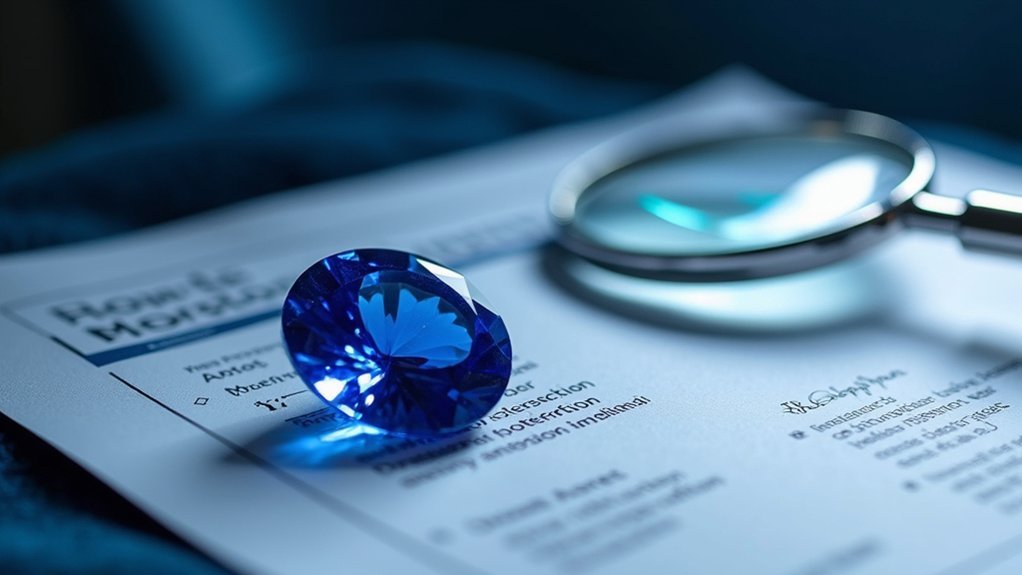
When should you go beyond a standard certificate for your precious gemstone purchase?
Though certification provides basic assurance, certain situations warrant additional scrutiny to protect your investment and confirm authenticity.
Request further testing procedures when:
- The gemstone has undergone significant treatments like heat or dyeing that mightn’t appear on standard certification but substantially affect value.
- You’re investing in high-value colored gemstones where origin authentication can double or triple market value.
- The stone exhibits unusual characteristics or inclusions that raise questions about its natural formation.
Don’t hesitate to seek additional testing for gemstones showing high fluorescence or when purchasing from less reputable sources.
These extra verification steps guarantee you’re getting exactly what you’re paying for and provide peace of mind for significant investments.
Cost vs. Benefit: Is Premium Lab Certification Worth the Investment?
Why do premium lab certifications command prices ranging from $50 to several hundred dollars? These fees reflect the extensive expertise of gemologists and sophisticated equipment required for thorough gem quality assessment.
When you’re investing in premium certification from respected institutions like GIA or AGS, you’re paying for peace of mind and market leverage.
The benefits often outweigh the costs. A certified gemstone typically commands higher market value and proves easier to resell. The detailed reports verify gemstone authenticity and document any treatments, greatly impacting a stone’s worth.
Beyond monetary considerations, certification provides trust—both for you and future buyers. Fundamentally, premium certification isn’t just an expense; it’s an investment that protects against fraud and guarantees you’re getting exactly what you pay for.
Frequently Asked Questions
What Is the Most Trusted Gem Certification?
The Gemological Institute of America (GIA) is the most trusted gem certification you’ll find. They’re renowned for their rigorous standards and 4Cs grading system that guarantees objective, reliable diamond evaluations.
Which Certification Is Best for Gemstones?
For gemstones, GIA is generally considered the best certification due to its rigorous standards and global recognition. However, AGS is excellent for cut quality, while IGI offers faster turnaround times at lower costs.
How Do You Become a Lab Gemologist?
To become a lab gemologist, you’ll need to complete a recognized gemology program, pass certification exams, gain hands-on experience through internships, pursue continuous education, and join professional organizations in the gemstone industry.
How Much Does It Cost to Certify Gemstones?
You’ll spend $50-$500+ to certify gemstones depending on their value and complexity. Higher quality stones cost more, and prestigious labs like GIA charge premium fees. Expedited services will increase your costs considerably.
In Summary
Armed with these 10 tips, you’re now prepared to navigate the complex world of gemstone certification. Remember, a certificate isn’t just paperwork—it’s your guarantee of a stone’s authenticity and value. Don’t hesitate to ask questions, compare reports, and choose the right lab for your specific gemstone. Your knowledge is your best protection when making significant gemstone investments.

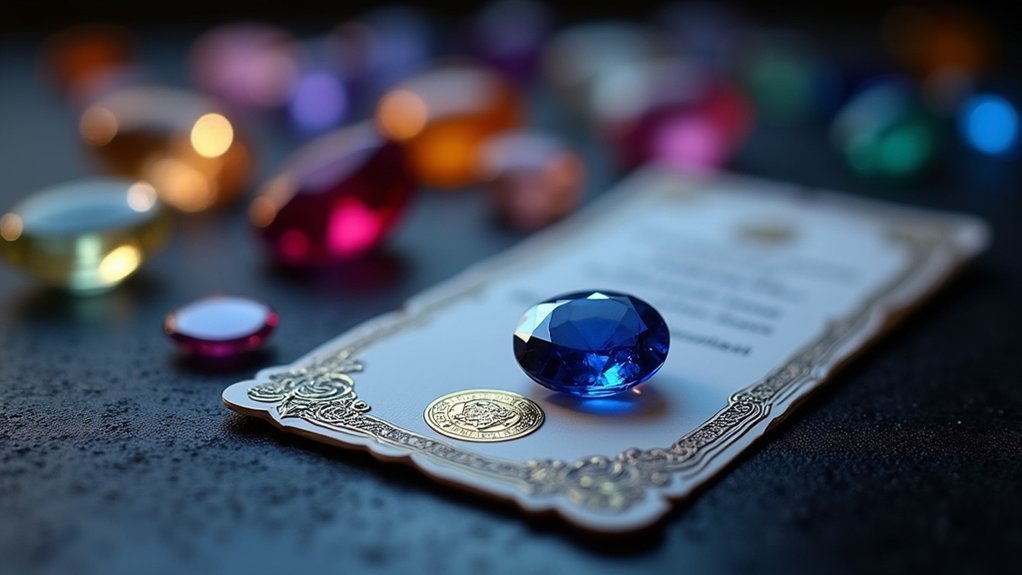



Leave a Reply